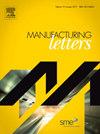Variations in temperature, residual stress, and distortion in collaborative robot-assisted patterned additive manufacturing
IF 1.9
Q3 ENGINEERING, MANUFACTURING
引用次数: 0
Abstract
Collaborative robots (COBOT) offer advantages over traditional robots by reducing the need for path programming, enhancing safety for human interaction, and improving user-friendliness and productivity, making them suitable for additive manufacturing of large and complex parts. COBOT simplifies path planning in patterned additive manufacturing by using teaching points where a complex deposition pattern can be represented by a few key coordinates. However, the selection of teaching points significantly affects the temperature fields, deposit geometry, residual stresses, and distortion, and these effects are not well understood. Here we use a combined experimental and computational approach to study the effects of four patterns with different teaching points (4, 5, 6, and 8) during wire arc-directed energy deposition (WA-DED) of stainless steel. Experiments are performed using an in-house COBOT-assisted WA-DED system. Finite element modeling is done to compute temperature fields, deposit geometry, residual stresses, and distortion. We concluded that the distribution of residual stress varies notably with different deposition patterns, even though the maximum stress values are not significantly different. Stress tends to accumulate at sharp corners where the arc heat source stays longer. In addition, thermal distortion is present in all parts due to variations in the temperature field, with the highest distortion occurring farthest from the molten pool. However, overall distortion remains comparable across parts due to a consistent total heat input.

协同机器人辅助模式增材制造中温度、残余应力和变形的变化
与传统机器人相比,协作机器人(COBOT)减少了对路径规划的需求,增强了人机交互的安全性,提高了用户友好性和生产率,使其适用于大型复杂部件的增材制造。COBOT通过使用教学点来简化模式增材制造中的路径规划,其中复杂的沉积模式可以由几个关键坐标表示。然而,教学点的选择会显著影响温度场、沉积几何形状、残余应力和变形,而这些影响尚未得到很好的理解。本文采用实验与计算相结合的方法,研究了不同点位(4、5、6、8)下四种模式对不锈钢电弧定向能沉积(WA-DED)过程的影响。实验使用内部cobot辅助的WA-DED系统进行。进行有限元建模以计算温度场、沉积几何形状、残余应力和变形。结果表明,尽管最大应力值没有显著差异,但不同沉积方式下的残余应力分布有显著差异。在电弧热源停留时间较长的尖角处,应力趋于积累。此外,由于温度场的变化,所有部分都存在热变形,最大的变形发生在离熔池最远的地方。然而,由于总热量输入一致,各部件的整体变形仍然具有可比性。
本文章由计算机程序翻译,如有差异,请以英文原文为准。
求助全文
约1分钟内获得全文
求助全文
来源期刊

Manufacturing Letters
Engineering-Industrial and Manufacturing Engineering
CiteScore
4.20
自引率
5.10%
发文量
192
审稿时长
60 days
 求助内容:
求助内容: 应助结果提醒方式:
应助结果提醒方式:


